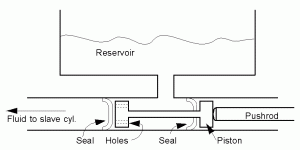JohnnyO
Senior Member
Offline
Why does hydraulic fluid leak out of the top of my master cylinder filler cap?? 66 Midget, dual master cylinder (rebuilt by Whitepost Restorations last winter) new stainless steel brake lines, the brakes and clutch all work wonderfully, fluid filled to just below the bottom of the filler neck. But when I pumped the brake pedal and clutch pedal either in the garage or out driving it, I end up with fluid leaking out the top of my filler cap!!?? Any ideas??

 Hi Guest!
Hi Guest!

 smilie in place of the real @
smilie in place of the real @
 Pretty Please - add it to our Events forum(s) and add to the calendar! >>
Pretty Please - add it to our Events forum(s) and add to the calendar! >> 

